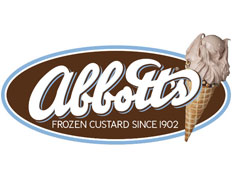There are a lot of frozen-dessert chains out there, says Gail Drew, president of the Rochester, New York–based Abbott’s Frozen Custard, but they just don’t have the history of Abbott’s.
“Everybody in Rochester has an Abbott’s story,” she says. “They grew up on it. Now we want to share that history with the rest of the country.”
Abbott’s Frozen Custard got its start in 1902 when Arthur Abbott traveled with small carnivals along the eastern seaboard. He set up shop permanently in Rochester in 1926. When Abbott decided to move on, Drew’s parents, Leonard and Thelma Schreiber, heard about the opportunity and in 1957 bought the business.
“After two decades of inquiries, the company started franchising in the Rochester area in 1977,” Drew says. A few stores also sprang up in random locations around the country whenever displaced Rochester natives who missed their frozen custard fix became franchisees.
Today, there are Abbott’s Frozen Custard stores in four states, with the vast majority—35, to be exact—in New York State. Of those, 26 are in the Rochester area.
“The chain has been growing slowly,” Drew says. “We’ve saturated the market here in Rochester, but now we have the structure in place to go beyond this area.”
Part of establishing stores outside of Western New York, she says, is educating people about frozen custard.
“Often people aren’t exactly sure what frozen custard is,” Drew says. “They see the cone in our logo and know it’s an ice cream product, but I tell them to taste it and tell me what the difference is.”
Like ice cream, frozen custard is served in cones or dishes and used as the base for shakes, sundaes, and floats. The difference is that custard contains eggs and has a higher percentage of butterfat than most standard ice creams. Custard is also churned more slowly than ice cream. It’s not whipped, so there is no air in it, making it thicker than ice cream.
“It’s creamy, smooth, and has very intense flavor,” Drew says.
Drew says the pieces are in order for Abbott’s expansion now that the appropriate warehousing is in place and a revamped store design is on the market.
“If we could grow, realistically, 5–10 stores a year, that would be great,” she says.
Abbott’s has several different formats. Some are strictly walk-up venues with outside seating, while half are walk-in stores and 10 are located inside Bill Gray’s, a Western New York family restaurant chain.
The new design made its debut this year at a new store in Broomfield, Colorado, and will be slowly rolled out to all locations.
“With the new design, we really tried to capture the essence of Abbott’s,” Drew says. “The richness, the wholesomeness, the tradition. We wanted people to walk into Abbott’s and get it immediately. So the stores are very bright and warm feeling. We used soft colors … chocolate and a soft, pretty shade of blue. Blue is traditional; we’ve always had blue.”
The prototype store is 1,000 square feet. It has seating at a counter with stools and a few tables, plus outside seating wherever possible. A drive thru can be incorporated into the design on a freestanding building or one positioned on an end-cap.
“We have two stores with drive thrus right now and they are very popular,” Drew says.
Abbott's Frozen Custard
PRESIDENT: Gail Drew
HQ: Rochester, New York
YEAR STARTED: 1902
ANNUAL SALES: Undisclosed
TOTAL UNITS: 43
FRANCHISE UNITS: 38
Custard is made fresh at each location throughout the day. Stores get what Drew calls “a blank mix” from Abbott’s. Employees flavor the mix, following Abbott’s specific recipes, and then put the mix into a machine that churns it.
“The mix is a liquid that looks like heavy cream,” Drew says. “It gets flavored, churned, and frozen in the stores.”
Abbott’s always has vanilla, chocolate, and its signature flavor, chocolate almond. Customers have the additional choice every day of one chunky flavor of the day and one or two traditional smooth flavors. Rotating flavors include Heavenly Snickers, Blue Ribbon Blueberry Pie, Cake Batter, Mango, and Maple Walnut.
“We have a flavor rotation list, and we hope they follow it, but you won’t necessarily have the same flavors in every store every day,” Drew says. “In certain areas certain flavors are more popular.”
Abbott’s doesn’t set prices for the stores either, but Drew says an average customer ticket is about $6. That figure is made slightly higher than the price of an individual dessert item by the fact that in addition to cones, dishes, and sundaes, stores sell custard by the pint and quart to go. Stores also sell ice cream cakes, pies, and some novelty items, including the Custard Turtle on a stick, made with vanilla or chocolate custard mixed with chocolate sauce and nuts then dipped in chocolate.
Drew says take-home items account for about 15 percent of a store’s business. And while custard is the mainstay of the business, frozen yogurt and sorbet have been added to the menu to meet a few customers’ requests for a lower fat option.
Abbott’s locations are typically open from 11 a.m. to 10 p.m. on weekdays and 11 a.m. to 11 p.m. on weekends during the summer months. About half of the Abbott’s locations close for winter.











